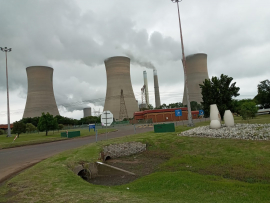
Eskom Chief Executive, Andre de Ruyter, says the power utility will not be implementing stage two load shedding at the flood-hit eThekweni Municipality in KwaZulu-Natal.
Despite this promise, some areas in the KZN region are without power due to damaged Eskom infrastructure, which the power utility is attending to.
“By and large, our grid is still intact. We have some minor interruptions in isolated areas where there are some short-term interruptions. We have offered some assistance to municipalities in KZN to help with spares and maintenance crews.
“We have made an arrangement with eThekwini Municipality and we are not implementing load shedding at this point in time. We are ready and prepared to offer any assistance that we can to help KZN through this very challenging period,” he said.
Load shedding
De Ruyter said the power utility is working “as hard as [it] can” to return units to service and to attend to broken down generation units, which have led to the implementation of stage two load shedding.
“We are working as hard as we can to restore electricity and end load shedding as soon as possible. We apologise for this interruption to our normal services and I can give the assurance that the Eskom teams are working all hours of the day and night to restore supply and end load shedding as soon as we can,” de Ruyter said.
He said the power utility is down on capacity of about 13 663MW, which will result in the power utility falling short – by some 3 518MW – of consumer demand.
“We had to take a decision to extend load shedding... at least until Friday, depending on how the situation changes with units either returning to service from unplanned trips or potential further breakdowns and of course, that risk remains,” he said.
Breakdowns and trips at the power utility’s power stations are:
- A shutdown at Komati power station unit nine.
- A trip at Majuba Power Station’s unit six.
- An interruption at the Apollo substation, which transmits at least 220MW electricity imported from Mozambique’s Cahora Bassa hydroelectric power station.
- A unit tripped at Grootvlei Power Station.
- A unit was lost at Camden Power Station.
- A boiler tube leak tripped the Medupi Power Station’s unit two.
Furthermore, units at risk are in excess of 11000MW of power.
Turning to the power utility’s emergency reserve capacity, De Ruyter said Eskom is not currently burning any diesel at its emergency and peak hour generating power station, Ankerlig.
“We have been able to keep Ankerlig diesel supply stable. We have about 28 hours left at the power station but of course, we have to maintain that reserve in the event that there are further losses of more generation units. We have to keep a buffer in order to prevent an overall system blackout.
“At Gourikwa power station… we are currently running five units and we’ve got 35 hours of generating capacity, with diesel levels sitting at just over 83%,” he said.
The power utility’s water pumped storage facility in Drakensburg has 57 hours of generation capacity and Ingula Pumped Storage Scheme, which has been affected by heavy rain, has some 24 hours generation capacity.
“We anticipate that we will require 11 open cycle gas turbines to get us through this evening’s peak [and] again, we appeal to South African public to please be responsible in how they manage their electricity consumption. It makes a difference and it will really help us to protect those emergency reserves.
“We require, in order to provide for any unforeseen events, reserves of about 2 200MW and therefore we do need to preserve diesel and maintain our dam levels. We can’t simply run them to depletion and take a risk of coal-fired units tripping, which would then create a very risky situation for us in terms of the overall grid stability,” he said. – SAnews.gov.za


